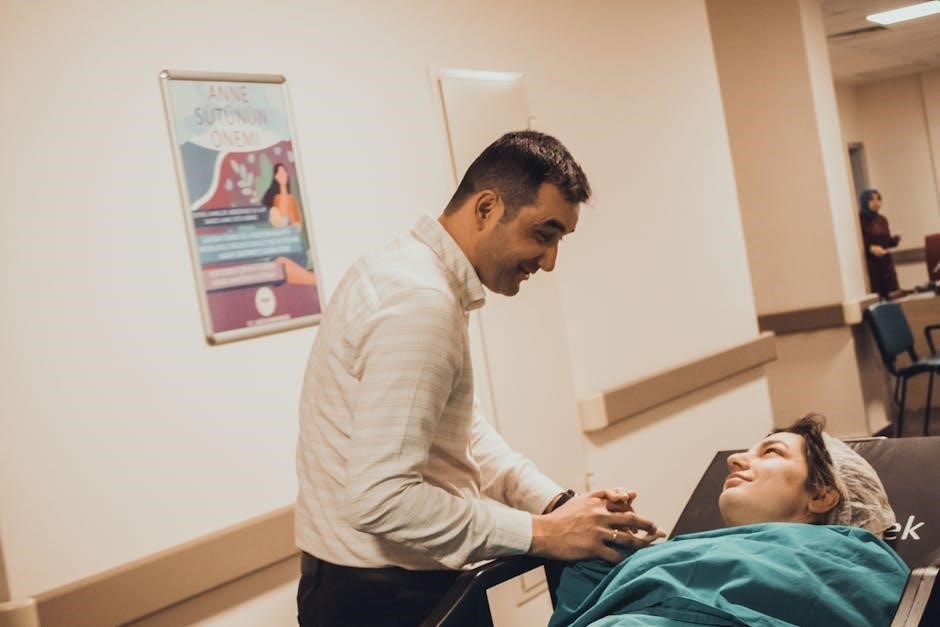Massachusetts jury instructions clarify the legal framework for establishing a doctor-patient relationship‚ emphasizing its role in medical malpractice cases. These instructions guide jurors on assessing negligence‚ causation‚ and damages‚ ensuring a fair evaluation of healthcare providers’ duties and standards of care.
Overview of Jury Instructions in Medical Malpractice Cases
Massachusetts jury instructions in medical malpractice cases provide a framework for jurors to evaluate claims involving the doctor-patient relationship. These instructions outline the legal standards for negligence‚ breach of duty‚ and causation‚ ensuring jurors understand the specific duties of healthcare providers. They emphasize the importance of expert testimony and the standard of care expected in similar circumstances. The instructions also address the continuing treatment doctrine‚ which delays the accrual of a malpractice claim while treatment continues. This structured approach helps jurors apply the law to the evidence presented‚ facilitating fair and informed verdicts in complex medical cases.
Importance of the Doctor-Patient Relationship in Legal Proceedings
The doctor-patient relationship is the cornerstone of medical malpractice cases‚ as it establishes the foundation for a healthcare provider’s duty of care. This relationship is not merely a casual interaction but involves active participation in a patient’s care‚ which legally binds the practitioner to adhere to a specific standard of care. The existence of this relationship is critical for determining negligence‚ as it defines the scope of the practitioner’s legal responsibilities and the standard of care expected. Without it‚ claims of malpractice cannot proceed‚ making its establishment essential for the legal framework of such cases.
Proving the Existence of a Doctor-Patient Relationship
Proving the existence of a doctor-patient relationship requires evidence of active participation in a patient’s care‚ evaluation‚ or treatment‚ beyond a casual interaction‚ and continuity of treatment when necessary.
Definition and Key Elements
A doctor-patient relationship is defined as a formal connection where a healthcare provider engages in the evaluation‚ care‚ or treatment of a patient. Key elements include active participation by the practitioner‚ a clear patient-practitioner interaction‚ and documentation of the relationship. The relationship must extend beyond casual advice or informal discussions‚ requiring a level of professional commitment. Establishing this relationship is essential for determining legal obligations and standards of care in medical malpractice cases‚ ensuring accountability and proper patient treatment.
Case Law Precedents
Massachusetts case law establishes that a doctor-patient relationship requires active participation in a patient’s care‚ beyond casual advice. Cases like Santos v. Kim and Letch v. Daniels highlight the necessity of a formal relationship for legal obligations. These precedents guide jury instructions‚ ensuring consistency in defining the relationship and its implications in malpractice claims. They emphasize the importance of documentation and professional commitment‚ shaping how courts evaluate the existence and scope of the doctor-patient relationship in legal proceedings.

Legal Elements of Medical Malpractice
Medical malpractice requires proving duty of care‚ breach‚ causation‚ and damages. The duty arises from the doctor-patient relationship‚ with breach involving substandard care causing harm.
Duty of Care
A duty of care arises when a doctor-patient relationship is established‚ requiring healthcare providers to deliver care according to accepted medical standards. This duty mandates that physicians act with the same skill and care as a reasonably competent practitioner in similar circumstances. The relationship is formed when a doctor participates in a patient’s evaluation‚ care‚ or treatment‚ beyond casual interactions. Jurors are instructed to assess whether the defendant’s actions met this duty‚ ensuring patients receive competent care aligned with professional standards.
Breach of Duty
A breach of duty occurs when a healthcare provider fails to meet the standard of care expected in a doctor-patient relationship. This happens when actions deviate from what a reasonably skilled practitioner would do under similar circumstances. Jurors are instructed to determine if the defendant’s conduct fell below the required standard‚ considering expert testimony and evidence. A breach is not merely a poor outcome but a failure to exercise proper skill and care. This step is crucial in establishing negligence in medical malpractice cases.
Causation
Causation requires proving that the defendant’s breach of duty directly caused the plaintiff’s harm. In Massachusetts‚ jurors are instructed to determine if the defendant’s actions were the proximate cause of the injury. This means the harm must be a foreseeable result of the negligence. Expert testimony often plays a key role in establishing this link. The plaintiff must show that‚ more likely than not‚ the defendant’s conduct caused the harm‚ ensuring a clear connection between the breach and the resulting damages.
Damages
Damages in Massachusetts medical malpractice cases must be proven to have resulted directly from the defendant’s negligence. Jurors are instructed to consider both economic and non-economic losses‚ such as medical expenses‚ lost wages‚ pain and suffering‚ and diminished quality of life. Plaintiffs must provide evidence‚ often through expert testimony‚ to quantify these damages. Massachusetts law allows for compensatory damages to restore the plaintiff to their pre-injury state‚ though punitive damages are rare and require proof of reckless or intentional conduct. The jury assesses the extent of harm to determine fair compensation.
Key Legal Doctrines
The Continuing Treatment Doctrine delays the statute of limitations until treatment ends‚ emphasizing the specific importance of ongoing care in the doctor-patient relationship and legal proceedings.
The Continuing Treatment Doctrine
The Continuing Treatment Doctrine in Massachusetts delays the statute of limitations for medical malpractice claims‚ allowing the accrual period to begin when treatment concludes. This doctrine acknowledges the ongoing nature of the doctor-patient relationship‚ ensuring patients can pursue legal remedies without rushing to file during active care. It emphasizes the importance of maintaining trust and continuity in treatment‚ balancing patient rights with the need for timely legal action. This doctrine is crucial in cases involving prolonged or complex medical care.

Jury Instructions in Specific Cases

Massachusetts jury instructions are tailored to the facts and legal standards of each case‚ ensuring clarity for jurors on evaluating the doctor-patient relationship and malpractice claims.
Examples from Massachusetts Case Law
In Letch v. Daniels‚ the court emphasized that a doctor-patient relationship requires direct participation in a patient’s care‚ beyond casual interactions. Santos v. Kim further clarified that such a relationship exists when a physician provides medical advice or treatment‚ even without direct physical examination. These cases illustrate how Massachusetts courts define the boundaries of the doctor-patient relationship‚ influencing jury instructions in malpractice trials. They highlight the importance of clear legal standards to guide jurors in assessing negligence and liability in medical cases.

Formulating Effective Jury Instructions

Effective jury instructions ensure clarity and precision‚ guiding jurors to understand legal standards and apply evidence accurately. Clear language helps jurors grasp complex medical and legal concepts‚ ensuring fair outcomes.
Best Practices for Clear and Concise Instructions
Best practices for crafting clear jury instructions involve using plain language and avoiding legal jargon. Judges should ensure instructions are logically structured‚ reflecting current legal standards. They should also provide definitions for key terms‚ such as “standard of care” and “breach of duty.” Additionally‚ instructions should be tailored to the specific case‚ highlighting relevant evidence and legal principles. This approach helps jurors understand their role and apply the law accurately‚ promoting fair and informed verdicts in medical malpractice cases. Regular updates to instructions ensure alignment with evolving case law and statutes.
Role of the Massachusetts Superior Court Civil Practice Jury Instructions
The Massachusetts Superior Court Civil Practice Jury Instructions provide standardized‚ legally accurate guidelines for judges to communicate complex legal principles clearly to jurors‚ ensuring consistency and fairness in trials;
Structure and Purpose of Model Instructions
The Massachusetts Superior Court Civil Practice Jury Instructions are structured to provide clear‚ concise legal guidance. They outline the essential elements of claims‚ such as the doctor-patient relationship‚ duty of care‚ breach‚ causation‚ and damages. The purpose is to ensure jurors understand the legal standards and apply them consistently. These instructions are regularly updated to reflect changes in case law and statutes‚ ensuring they remain relevant and accurate for both judges and practitioners.

High-Profile Cases Involving Doctor-Patient Relationships
A Massachusetts spine doctor was indicted for sexually assaulting patients‚ highlighting the importance of upholding ethical standards in the doctor-patient relationship and ensuring accountability.
Notable Cases and Their Impact on Legal Standards
High-profile cases in Massachusetts‚ such as the indictment of Dr. Ho Yin Aaron Shiu for sexual assault and the conviction of Dr. Rita Luthra for illegally sharing patient information‚ have significantly influenced legal standards. These cases underscore the importance of maintaining ethical boundaries and confidentiality in the doctor-patient relationship. They have also led to clearer jury instructions‚ ensuring jurors understand the nuances of medical malpractice and the thresholds for proving negligence. Such rulings have strengthened legal protections for patients while setting precedents for healthcare providers’ accountability.
Massachusetts jury instructions on the doctor-patient relationship provide clarity on legal standards‚ ensuring accountability in medical malpractice cases while balancing patient and provider interests effectively.
Massachusetts jury instructions on the doctor-patient relationship outline the legal framework for establishing this relationship in medical malpractice cases. They emphasize the importance of proving duty‚ breach‚ causation‚ and damages. The instructions also address the continuing treatment doctrine and the role of model jury instructions in ensuring clarity and fairness. Jurors are guided to evaluate whether the defendant met the standard of care and whether any deviations caused harm. These instructions are crucial for balancing patient rights and healthcare provider accountability in Massachusetts courts.

